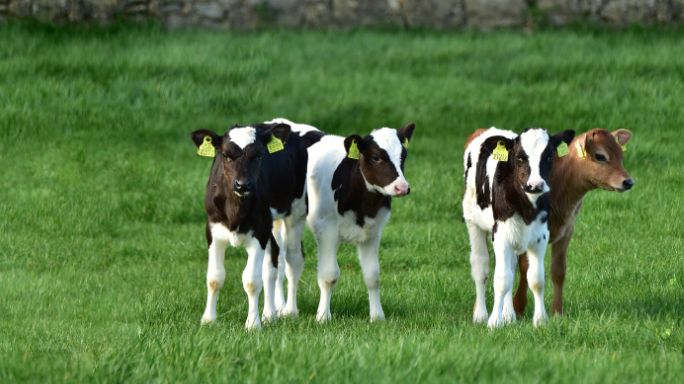Effective youngstock worm control during the grazing season 2024

Calves are born free of parasites and the development of immunity against worms will depend on exposure during the grazing season.
However, excessive exposure will result in reduced growth rates or even clinical disease such as scour caused by stomach worms or coughing due to lungworm. Even in the absence of clinical signs, weight gain in calves can be reduced as much as 20% during the first grazing season due to high stomach worm burden. Lungworm and Liver fluke can further contribute to poor performance in youngstock resulting in missing the target body weight at breeding and delayed age at first calving.
Once the grazing season starts, animals of all ages are exposed to parasites. The poor weather until recently may have delayed turning out calves by a few weeks and it is difficult to predict how the weather has impacted the number of worm eggs that survived on pasture from last year. Higher temperatures in combination with rainfall in recent weeks will lead to rapid development of the worm larvae from eggs that did survive the winter, leaving grazing animals at risk of sudden parasite exposure.
- When young calves go to grass they have no immunity to stomach worms or lungworms (the cause of hoose)
- Due to the lack of immunity there will be a large production of worm eggs transferred onto the pasture via dung
- Calves can quickly pick up a heavy infection of stomach worms, before they have developed a protective immunity
- First grazers born last autumn or this spring will be at highest risk of disease
- Yearling cattle, in their second grazing season, are also still at risk of disease as their immunity against worms will not have fully developed yet
Control of parasite burden
The control of worms and fluke is based on:
- Grazing management
- Good nutrition
- Appropriate use of anthelmintics
- Grazing management
The objective is to reduce the concentration of infective larvae on pasture and so reduce the parasite challenge to grazing animals. Especially first grazing season animals should be turned out to clean pasture. Clean pasture is reseeded paddocks, silage aftermath or land not grazed by young cattle since mid-summer last year.
- Good nutrition
Good quality grazing and appropriate concentrate supplementation can partially offset the negative effects of parasite infection and the associated reduced appetite. Well-nourished cattle are also better suited at building up immunity against parasites and limit parasites multiplying.
- Appropriate use of anthelmintics
Anthelmintic resistance of some degree exists against all classes of dosing products. This could jeopardise the effectiveness of these products in the future. Therefore, these drugs must be used carefully in order to benefit both animals and farmers. Be tactical in how you use anthelminthics and monitor calf and replacement heifer weight gains and carry out faecal testing, only treating when appropriate. Grazing these animals on silage aftermath will reduce the need for repeated treatment. In case of identification of rumen fluke eggs in dung samples, treatment is certainly not indicated if animals are thriving.
Explained: The Refugia concept in worm dosing
Refugia is the technical term for maintaining a proportion of susceptible worms on your farm that have not been exposed to anthelmintic dosing. This concept is of great value in delaying the development of resistance in stomach-, gut- and lungworm against the commonly used dosing products. Refugia can be both worm populations in untreated animals and worm populations living on paddocks.
Strategies to keep worms in Refugia:
- Do not dose animals and immediately move them to a ‘clean’ paddock.
- This strategy will not work for drugs with a long persistent activity such as clear wormers/ivermectins.
- Allow animals recently treated with a white or yellow wormer to continue to graze contaminated pasture for 4-7 days. This allows a low level of reinfection from the environment with eggs or larvae that were not exposed to the dosing treatment.
- When the stock is eventually moved, they will take with them a mixture of susceptible and resistant worms to the new paddock, rather than only resistant worms.
- Mature cows typically do not require treatment during the grazing season and can be a good source of a relatively low number of untreated/susceptible worms on pasture.
- Use faecal egg counts and weight gain targets for youngstock, and bulk tank results for dairy cows, to monitor for evidence of parasite infection. This will allow you to target treatment only to those groups or individuals that need it.
Do not continue to use ineffective wormers. Monitor to ensure that the anthelmintics used on your farm are still effective and investigate any cases where resistance is suspected. Talk to your vet to perform a faecal egg count reduction test or a drench test rule out incorrect dosage technique and suggest alternative anthelmintic classes for treatments.
Note of warning:
Adult cows and pregnant heifers:
It is rare for adult cattle to show signs of disease from gut worm infestation, yet, dairy cows can experience production losses due to stomach worms. Milk yield, Body Condition Score and Fertility can all benefit from treatment.
However, to ensure the safety of the food ingredients, producers must ensure that milk is free from chemical residues, including anthelmintic products at all times. Withhold periods must be adhered to for all anthelmintic treatments and it should be noted that some anthelmintic products are not licensed for use in milk producing cows and heifers intended for milk production. Always read the product labels and consider the type of animal that is receiving the treatment.
First Published 14 May 2024
Tagged with: Dairy